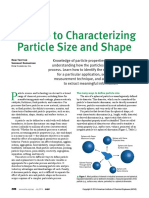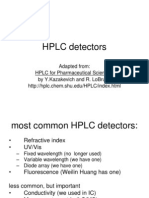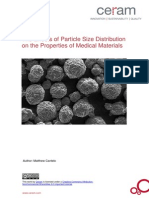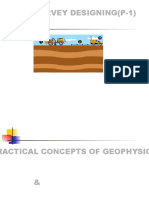Laser Diffraction For Particle Sizing
Laser Diffraction For Particle Sizing
Uploaded by
unknown_cool_18Copyright:
Available Formats
Laser Diffraction For Particle Sizing
Laser Diffraction For Particle Sizing
Uploaded by
unknown_cool_18Original Title
Copyright
Available Formats
Share this document
Did you find this document useful?
Is this content inappropriate?
Copyright:
Available Formats
Laser Diffraction For Particle Sizing
Laser Diffraction For Particle Sizing
Uploaded by
unknown_cool_18Copyright:
Available Formats
Laser diffraction for particle sizing
Introduction: By far the most important physical property of particulate samples is particle size. Particle size measurement is routinely carried out across a wide range of industries and is often a critical parameter in the manufacture of many products. Particle size has a direct influence on material properties such as:
Reactivity or dissolution rate - e.g. catalysts, tablets Stability in suspension e.g. sediments, paints Efficacy of delivery e.g. asthma inhalers Texture and feel e.g. food ingredients Appearance e.g. powder coatings and inks Flowability and handling e.g. granules Viscosity e.g. nasal sprays Packing density and porosity e.g. ceramics
Measuring particle size and understanding how it affects your products and processes can be critical to the success of many manufacturing businesses. The link between particle size and product performance is well documented with regards to dissolution, absorption rates and content uniformity. Reducing particle size can aid the formulation of NCEs (New Chemical Entities) with poor water solubility. Proper matching of active ingredient and excipient particle size is important for several process steps. Particle size analysis is an integral component of the effort to formulate and manufacture many pharmaceutical dosage forms. Laser diffraction: Laser diffraction is the most popular particle size analysis technique used in the pharmaceutical industry. Laser diffraction is a widely used particle sizing technique for materials ranging from hundreds of nanometers up to several millimeters in size. The main reasons for its use are:
Wide dynamic range - from submicron to the millimeter size range. Rapid measurements - results generated in less than a minute. Repeatability - large numbers of particles are sampled in each measurement. Instant feedback - monitors and controls the particle dispersion process.
High sample throughput - hundreds of measurements per day. Calibration not necessary - easily verified using standard reference materials.
Principle Laser diffraction measures particle size distributions by measuring the angular variation in intensity of light scattered as a laser beam passes through a dispersed particulate sample. Large particles scatter light at small angles relative to the laser beam and small particles scatter light at large angles, as illustrated below. The angular scattering intensity data is then analyzed to calculate the size of the particles responsible for creating the scattering pattern, using the Mie theory of light scattering. The particle size is reported as a volume equivalent sphere diameter.
Scattering of light from small and large particles. Assumptions of Laser diffraction: Spherical, non-porous and opaque particles, Diameter d > wavelength l, Particles are distant enough from each other, Random motion, All the particles diffract the light with the same efficiency, regardless of their shape
Optical properties Laser diffraction uses Mie theory of light scattering to calculate the particle size distribution, assuming a volume equivalent sphere model.
Mie theory requires knowledge of the optical properties (refractive index and imaginary component) of both the sample being measured, along with the refractive index of the dispersant. Usually the optical properties of the dispersant are relatively easy to find from published data, and many modern instruments will have in-built databases that include common dispersants. For samples where the optical properties are not known, the user can either measure them or estimate them using an iterative approach based upon the goodness of fit between the modeled data and the actual data collected for the sample. Mie Theory: The Mie model takes into account both diffraction and diffusion of the light around the particle in its medium. To use the Mie model, it is necessary to know the complex refractive index of both the sample and the medium. This complex index has a real part, which is the standard refractive index, and an imaginary part, which represents absorption. Complex index = m m=a+b where a: real part, b: imaginary part. Instrumentation:
Photo courtesy (http://www.shimadzu.com) As shown in Figure, the diffracted/scattered light intensity distribution pattern is generated spatially when a measurement target particle group is irradiated with a laser beam. The light intensity distribution pattern of the forward scattered light is condensed by the lens, and a ringshaped diffracted/scattered image is formed on the detecting plane located at the focal distance. This is detected by a ring sensor comprising sensing elements placed concentrically. Side scattered light and backward scattered light are detected by side scattered light sensors and backward scattered light sensors, respectively. In this way, various sensing elements are used to
detect the light intensity distribution pattern to obtain light intensity distribution data. The light intensity distribution data changes according to the size of the particle. Because actual samples contain a mixture of different size particles, the light intensity distribution data generated from a particle group is the result of overlaid diffracted/scattered light from each respective particle. References: BASIC PRINCIPLES OF PARTICLE SIZE ANALYSIS Written by Dr. Alan Rawle,Malvern Instruments Limited, Enigma Business Park, Grovewood Road, Malvern, Worcestershire, WR14 1XZ, UK. Tel: +44 (0)1684 892456 Fax: +44 (0)1684 892789 illavenkatesa A, Dapkunas S J, Lin-Sien Lum, Particle Size Characterization, NIST Special Publication 960-1, 2001 Laser Diffraction Particle Size Measurement of Food and Dairy Emulsions Using Equipment from Malvern Particle size distributions in skim milk by C. Holt, D.G. Dalgleish, T.G. Parker Hannah Research Institute, Ayr, KA6 5HL Great Britain Received 12 June 1973. Available online 28 January 2003 Particle size distribution analysis of soils using laser diffraction S. Wanogho, G. Gettinby, B. Caddy Forensic Science Unit, University of Strathclyde, Royal College, 204 George Street, Glasgow G1 1XH UK Department of Mathematics, University of Strathclyde, Glasgow G1 1XH UK Received 20 November 1985. Revised 30 June 1986. Accepted 27 August 1986. Available online 2 April 2004. New developments in particle characterization by laserdiffraction: size and shape Zhenhua Ma, Henk G Merkus, Jan G.A.E de Smet, Camiel Heffels, Brian Scarlett 7 July 2000. Sivakugan N, Soil Classification, James Cook University Geoengineering lecture handout, 2000 Terence Allen, ed. (2003). Powder sampling and particle size determination (1st ed. ed.). Amsterdam: Elsevier. ISBN 978-0-444-51564-3. Retrieved 22 August 2011. Fieller, N.R.J; Gilbertson, D.D. and Olbricht, W (1984). "A new method for environmental analysis of particle size distribution data from shoreline sediments". Nature 311 (5987): 648651.
You might also like
- Ca 800Document83 pagesCa 800Pablo CzNo ratings yet
- Analytical Chemistry II Classical Methods NotesDocument65 pagesAnalytical Chemistry II Classical Methods NotesOratile SehemoNo ratings yet
- Thermal Analysis UpdatedDocument18 pagesThermal Analysis UpdatedKD LoteyNo ratings yet
- P4 S1 SCIENCE Light and ShadowDocument2 pagesP4 S1 SCIENCE Light and ShadowValentina Sidharta100% (1)
- Light Reflection Numericals - Part 1Document1 pageLight Reflection Numericals - Part 1pmagrawal80% (20)
- Malvern Particle Size AnalyzerDocument2 pagesMalvern Particle Size AnalyzerPraveen H Praveen HNo ratings yet
- Thermal AnalysisDocument105 pagesThermal AnalysisRudrang Chauhan100% (1)
- 07 - RheologyDocument58 pages07 - RheologyPuspa DasNo ratings yet
- Protein Purification HandbookDocument94 pagesProtein Purification HandbookDolphingNo ratings yet
- XRD PPT Part 2Document39 pagesXRD PPT Part 2BME62Thejeswar SeggamNo ratings yet
- GPC Gel Permeation ChromatographyDocument3 pagesGPC Gel Permeation ChromatographyDavidNo ratings yet
- Operation and Application of Differential Scanning Calorimetry (DSC) in PharmaceuticalsDocument21 pagesOperation and Application of Differential Scanning Calorimetry (DSC) in PharmaceuticalsMd Tayfuzzaman100% (1)
- Atomic Spectroscopy 3Document36 pagesAtomic Spectroscopy 3Anonymous KzCCQoNo ratings yet
- Session 3 - Efficiency Element ICPDocument54 pagesSession 3 - Efficiency Element ICPHasanuddin NurdinNo ratings yet
- Optical ActivityDocument4 pagesOptical ActivityJohn Mark Flores Villena100% (1)
- 1725 UV-Vis GlossaryDocument16 pages1725 UV-Vis GlossaryEdi RismawanNo ratings yet
- Unit 10 Thermogravimetric AnalysisDocument24 pagesUnit 10 Thermogravimetric Analysismaidhily83% (6)
- PolarimetryDocument18 pagesPolarimetryLogavathanaa SamonNo ratings yet
- 1 - Text - A Guide To Characterizing Particle Size and Shape - 23AGO2020Document11 pages1 - Text - A Guide To Characterizing Particle Size and Shape - 23AGO2020Estefanía Gómez RodríguezNo ratings yet
- Measuring PH CorrectlyDocument33 pagesMeasuring PH CorrectlyAnonymous Z7Lx7q0RzNo ratings yet
- 2 HPLCDocument108 pages2 HPLCPepy PeachNo ratings yet
- ICP-AES and ICP-MSDocument64 pagesICP-AES and ICP-MSSiska Winti Sone100% (1)
- HPLC DetectorsDocument18 pagesHPLC DetectorssouvenirsouvenirNo ratings yet
- AABurner System A-700 800 PDFDocument115 pagesAABurner System A-700 800 PDFronal carhuaz condoriNo ratings yet
- GPCDocument39 pagesGPCRahul ChaudharyNo ratings yet
- Solvent Selection GuideDocument17 pagesSolvent Selection GuideNajuma Abdul RazackNo ratings yet
- Conductivity of Ionic SolutionsDocument3 pagesConductivity of Ionic SolutionsCristina AreolaNo ratings yet
- Colloids Introduction (MS I)Document27 pagesColloids Introduction (MS I)gauravNo ratings yet
- High Performance Thin Layer Chromatography HPTLC BY Simran Singh Rathore M Pharm Pqa (Mpat)Document38 pagesHigh Performance Thin Layer Chromatography HPTLC BY Simran Singh Rathore M Pharm Pqa (Mpat)Simran Singh RathoreNo ratings yet
- DSCDocument56 pagesDSCDildeep JayadevanNo ratings yet
- FAQs On Elemental ImpuritiesDocument6 pagesFAQs On Elemental ImpuritiesGiriNo ratings yet
- Electrical Conductivity Analyzer TufelDocument19 pagesElectrical Conductivity Analyzer Tufelurvish_soniNo ratings yet
- Class 1 - New (4 Files Merged)Document54 pagesClass 1 - New (4 Files Merged)alok nayak100% (1)
- Brochure TGA DSC1Document14 pagesBrochure TGA DSC1Angela MoraNo ratings yet
- A Seminar On A Seminar On: HPLC Detectors HPLC DetectorsDocument36 pagesA Seminar On A Seminar On: HPLC Detectors HPLC DetectorsVivek SagarNo ratings yet
- AN148 ORAC Trolox Antioxidants Fluorescence FLUOstarDocument2 pagesAN148 ORAC Trolox Antioxidants Fluorescence FLUOstarWinne SiaNo ratings yet
- HPLC Detectors: Adapted From: HPLC For Pharmaceutical Scientists by Y.Kazakevich and R. LobruttoDocument7 pagesHPLC Detectors: Adapted From: HPLC For Pharmaceutical Scientists by Y.Kazakevich and R. LobruttogunaseelandNo ratings yet
- Tandem MS For Drug AnalysisDocument93 pagesTandem MS For Drug AnalysisrostaminasabNo ratings yet
- Lecture HPLC StudentDocument243 pagesLecture HPLC StudentNur Hariani100% (1)
- Thermal Methods of AnalysisDocument31 pagesThermal Methods of AnalysisTshegofatso GraceNo ratings yet
- Thermal Analysis: Presented By: MD Meraj Anjum M.Pharm 1 Year Bbau, LucknowDocument25 pagesThermal Analysis: Presented By: MD Meraj Anjum M.Pharm 1 Year Bbau, LucknowA. MerajNo ratings yet
- Chapter 1. Thermal Analysis: Dr. Nguyen Tuan LoiDocument36 pagesChapter 1. Thermal Analysis: Dr. Nguyen Tuan LoiNhung Đặng100% (1)
- UV-Vis Spectroscopy: Chm622-Advance Organic SpectrosDocument50 pagesUV-Vis Spectroscopy: Chm622-Advance Organic Spectrossharifah sakinah syed soffianNo ratings yet
- C5 IR SpectrosDocument13 pagesC5 IR SpectrossuryaNo ratings yet
- TDS Lldpe 7042Document1 pageTDS Lldpe 7042jayce010322No ratings yet
- 4 XRDDocument59 pages4 XRDMaaz ZafarNo ratings yet
- Optical-Methods Part1Document7 pagesOptical-Methods Part1Sumedha Thakur0% (1)
- RheologyDocument38 pagesRheologyKhairul Azman100% (1)
- Basic of XRD - 161130 PDFDocument68 pagesBasic of XRD - 161130 PDFHugo Ezra XimenesNo ratings yet
- Nanoparticle SynthesisDocument30 pagesNanoparticle Synthesisdevendrakphy100% (1)
- Pressure Driven ProcessesDocument14 pagesPressure Driven Processesdei_sandeep7994No ratings yet
- Differential Scanning Calorimetry (DSC) : Mr. Sagar Kishor SavaleDocument27 pagesDifferential Scanning Calorimetry (DSC) : Mr. Sagar Kishor SavaleDivya Tripathy100% (1)
- SCION 456-GC: Specification SheetDocument8 pagesSCION 456-GC: Specification SheetNashiha SakinaNo ratings yet
- 1 - Basics of Molecular SpectrosDocument56 pages1 - Basics of Molecular SpectroscalfontibonNo ratings yet
- Kerr MicrosDocument7 pagesKerr MicrosFabian LuxNo ratings yet
- Ftir Spectroscopy: PRESENTATION BY: BIPASHA SARKAR (2013712055003) M.Sc. I FTMDocument18 pagesFtir Spectroscopy: PRESENTATION BY: BIPASHA SARKAR (2013712055003) M.Sc. I FTMBipasha SarkarNo ratings yet
- Estimating Crystallite Size Using XRDDocument105 pagesEstimating Crystallite Size Using XRDKrizelle Ann HugoNo ratings yet
- Differential Scanning CalorimetryDocument7 pagesDifferential Scanning CalorimetryKenesei GyörgyNo ratings yet
- Visible and Ultraviolet Spectroscopy-Part 2Document54 pagesVisible and Ultraviolet Spectroscopy-Part 2Amusa TikunganNo ratings yet
- Thermal Analysis 3Document61 pagesThermal Analysis 3Itz HamzaNo ratings yet
- Inductively Coupled Plasma Optical Emission SpectrophotometerDocument5 pagesInductively Coupled Plasma Optical Emission Spectrophotometerfawadint100% (1)
- Appendix XVII P. Particle Size Analysis by Laser Light Diffraction - British PharmacopoeiaDocument5 pagesAppendix XVII P. Particle Size Analysis by Laser Light Diffraction - British PharmacopoeiaFarlane MtisiNo ratings yet
- The Effects of Particle Size Distribution On The Properties of Medical Materials With LicenseDocument8 pagesThe Effects of Particle Size Distribution On The Properties of Medical Materials With LicenseLucideonNo ratings yet
- Emft ProjectDocument11 pagesEmft ProjectBUKKE ANITHANo ratings yet
- 01 TDS - Destello 50 Surface-SuspendedDocument2 pages01 TDS - Destello 50 Surface-SuspendedPavithra ValluvanNo ratings yet
- Microwave Formula SheetDocument6 pagesMicrowave Formula Sheetunity123d deewNo ratings yet
- RRZZHHTT-65A-R6H4 Product Specifications (Comprehensive)Document6 pagesRRZZHHTT-65A-R6H4 Product Specifications (Comprehensive)jason zengNo ratings yet
- SHR-HTIR185 Long Range Thermal Imaging CameraDocument4 pagesSHR-HTIR185 Long Range Thermal Imaging CameraMary TianNo ratings yet
- Project-Wien's Displacement LawDocument14 pagesProject-Wien's Displacement LawMohammed Nadeemullah NNo ratings yet
- Test Questions - Module 1-Q2Document3 pagesTest Questions - Module 1-Q2Melody Mira IdulNo ratings yet
- 13 Newton Rings PDFDocument8 pages13 Newton Rings PDFWell KnownNo ratings yet
- Document Hand-OutDocument2 pagesDocument Hand-OutJoselito JualoNo ratings yet
- Prepp IAS Upcoming Courses For UPSC CSE Mains 2023: GramDocument38 pagesPrepp IAS Upcoming Courses For UPSC CSE Mains 2023: GramshivangiNo ratings yet
- Monika Zagrobelna - Improve Your Artwork by Learning To See Light and ShadowDocument74 pagesMonika Zagrobelna - Improve Your Artwork by Learning To See Light and ShadowNeoSagaNo ratings yet
- Class 12 Physics Chapter-Wise Weightage 2024: Anum AnsariDocument11 pagesClass 12 Physics Chapter-Wise Weightage 2024: Anum Ansarityagishivek65No ratings yet
- CLW - Apxvrll13 C A20Document2 pagesCLW - Apxvrll13 C A20YarinaNo ratings yet
- Nikkor Lens Broch - 061017Document18 pagesNikkor Lens Broch - 061017syladrianNo ratings yet
- Experiment 1Document3 pagesExperiment 1Christian Roy CNo ratings yet
- Lab 36Document5 pagesLab 36Jabran Ul-Haque100% (1)
- Barker 2020 Physics Trials & SolutionsDocument59 pagesBarker 2020 Physics Trials & SolutionsNhan LeNo ratings yet
- Question PhotographyDocument6 pagesQuestion PhotographyYumi TV100% (3)
- Pierm 15032605Document9 pagesPierm 15032605Imane MassaoudiNo ratings yet
- LED-Flyer 052020Document1 pageLED-Flyer 052020OSCAR LECHUGANo ratings yet
- 3d Survey DesigningDocument39 pages3d Survey Designinghamza khanNo ratings yet
- GenPhys2 Q4 M3 Geometric Optics Ver4 1Document53 pagesGenPhys2 Q4 M3 Geometric Optics Ver4 1Jeffa Mae IsioNo ratings yet
- Real-Time Investigations and Simulation On The Impact of Lighting Ambience On Circadian StimulusDocument14 pagesReal-Time Investigations and Simulation On The Impact of Lighting Ambience On Circadian Stimulussaharhatem815No ratings yet
- 1.6 Isotropic and Anisotropic MineralsDocument53 pages1.6 Isotropic and Anisotropic MineralsBowoxs Si War WerNo ratings yet
- ESR For TY As HandoutDocument16 pagesESR For TY As HandoutPavitra JonesNo ratings yet
- Physics Project-Finding Refractive Index of Transparent LiquidDocument15 pagesPhysics Project-Finding Refractive Index of Transparent Liquidram das61% (56)
























































































